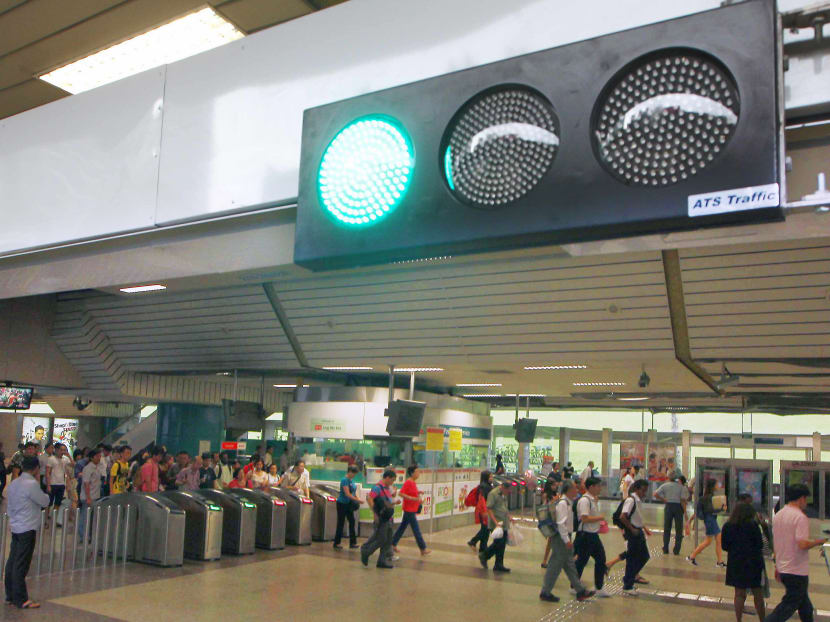10 more MRT stations to get ‘traffic lights’ showing crowd levels
SINGAPORE — Following what SMRT said was positive feedback from commuters, the transport operator will be rolling out its “traffic lights” system — green, amber and red lights to indicate how crowded MRT station platforms are — to 10 more stations with high passenger flow by the first half of next year.

A traffic light at an entrance of Ang Mo Kio station on Aug 21, 2014. The Traffic Light System was piloted at Ang Mo Kio and Tanjong Pagar stations in December 2013 and January 2014 respectively. Photo: Ooi Boon Keong
SINGAPORE — Following what SMRT said was positive feedback from commuters, the transport operator will be rolling out its “traffic lights” system — green, amber and red lights to indicate how crowded MRT station platforms are — to 10 more stations with high passenger flow by the first half of next year.
It will also install display systems that provide information on train delays at 15 more stations. The iDisplay panels are currently installed at 17 stations.
Mr Patrick Nathan, SMRT vice-president of corporate information and communications, told TODAY: “Commuters can be assured that while we introduce these new service enhancements, SMRT remains committed and focused on ensuring reliable train service through the procurement of new trains and ongoing asset renewal programmes. These include the refurbishment and mid-life upgrade of existing trains, the resignalling project and the replacement of track systems including sleepers and the third rail.”
The traffic lights system was piloted at the Ang Mo Kio and Tanjong Pagar MRT stations in December last year and January this year, respectively.
SMRT declined to reveal the locations of the next 10 stations where the system will be rolled out. Stations that have faced issues with congestion include the City Hall and Jurong East MRT stations.
Although analysts welcomed the system, they felt that commuters should be given more information at an earlier stage.
Dr Park Byung Joon, an urban transport expert from SIM University, said information should reach commuters early enough to allow them time to adjust their travel plans. He said: “They should make this information available on the Web or through a mobile app, so people can see it before they (reach the stations).”
Nanyang Technological University Assistant Professor Walter Theseira pointed out that the system is effective only in places where good transport alternatives are available. “In such a case (where there are no good alternatives), the signal would not appreciably affect commuter decision-making,” he said.
Mr Nathan said he hopes the system can assist commuters with their journey planning. An SMRT spokesman added that commuters could also check the operator’s Facebook page and Twitter account or use its SMRTConnect app to get more information.
Under the traffic light system, lights are installed at station entrances to indicate the crowd levels. If the lights are green, commuters can catch the arriving train. If the lights are amber, they have to wait for approximately two trains to pass before they can board. Red lights indicate prolonged waiting time.
The lights at the next 10 stations will be installed with reduced glare, following feedback that some lights might be too bright in underground conditions, SMRT said. It had conducted a survey of about 1,000 commuters on the system. More than 80 per cent of the respondents said they were aware of what it was for. Among these, 60 per cent said they referred to the lights before entering the station and 80 per cent felt the system should be rolled out to more stations.
Speaking to TODAY, several commuters who take the MRT regularly at Tanjong Pagar station said they did not notice the lights. Those who did, choose not to heed them. Mr Kenny Yap, 31, a public relations director, said: “Usually, by the time you want to take the train from there, you don’t have many alternatives. So you’ll still just go in and wait, unless the sign says there is a train breakdown.”
Ms Eunice Chan, 27, a user experience designer, added: “Even if I need to wait for a few more trains to pass by before I can get on, it’s just a few minutes more."






